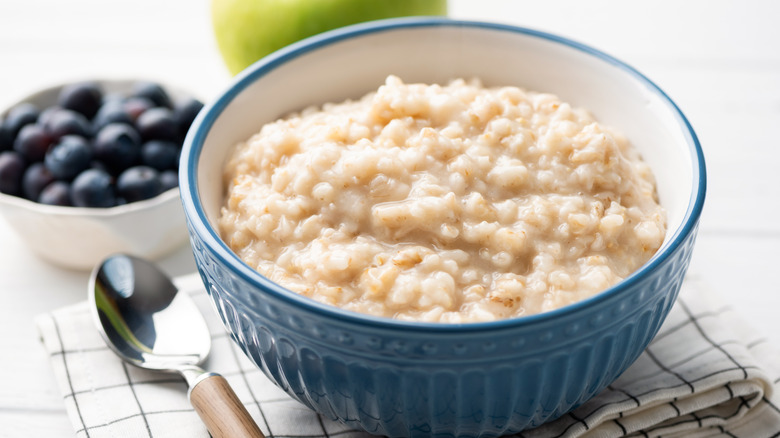How To Reheat Cooked Oatmeal So That It's Creamy
As many oatmeal lovers know, this breakfast staple is easy to make, but hard to master — and it can be even more difficult to deal with when reheated. You can do everything right when preparing oatmeal (paying attention to your liquid ratio, lowering the temperature of your cooking method, and even toasting your oats for added texture) and still wind up with goopy, bland, unappealing leftovers.
You can try a few different tricks to revitalize congealed oatmeal and return it to its original creamy state. Perhaps the easiest method is to add some milk or water to the oatmeal before reheating it, as the extra liquid will help loosen the mixture. If you're short on time, you can reheat your oatmeal in the microwave, but the stovetop is a gentler, better option. Using the stove, you can heat the oatmeal more slowly and evenly, gradually adding liquid until the consistency meets your satisfaction.
Another good rule of thumb is to use oats that reheat better. Instant oats, for example, are already prone to getting mushy when cooked the first time around, so their texture will only continue to decline with subsequent reheating. Rather, the best oats to use for reheated oatmeal are the same oats you should use for oatmeal cookies –- old-fashioned or rolled oats. These less processed products are sturdy enough to keep their texture after reheating, but still soft enough to create a deliciously creamy breakfast.
For a better reheated oatmeal, store your oatmeal the right way
While the way you reheat cooked oatmeal is of the utmost importance, how you store it between cooking and reheating is also crucial. For instance, you should never leave cooked oatmeal out on the counter overnight, as it can quickly grow bacteria and spoil. This is even more dangerous if you add milk, sweeteners, fruit, or other perishable add-ins. Similarly, you should avoid the food storage mistake of letting the oatmeal fully cool before refrigeration, as even this short amount of time outside of the fridge can allow bacterial growth. Instead, refrigerate it as quickly as possible.
Another consideration is the container you use. Sure, it might seem easiest to refrigerate your oatmeal in the bowl you intend to eat out of the next morning, but this exposes the oatmeal to the dry environment of the fridge — it will quickly turn goopy or even crusty. For the best results, store your oatmeal in an airtight container to keep bacteria out and moisture in. Following all of these guidelines, your cooked oatmeal should last for up to a week, at which point you should throw it out, even if it isn't showing signs of spoilage.


